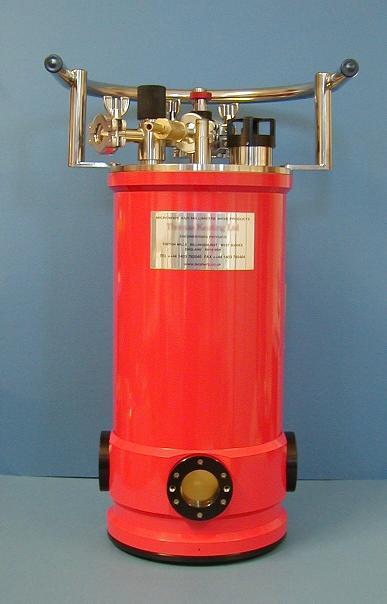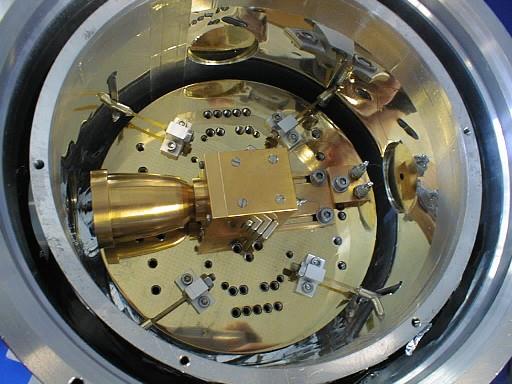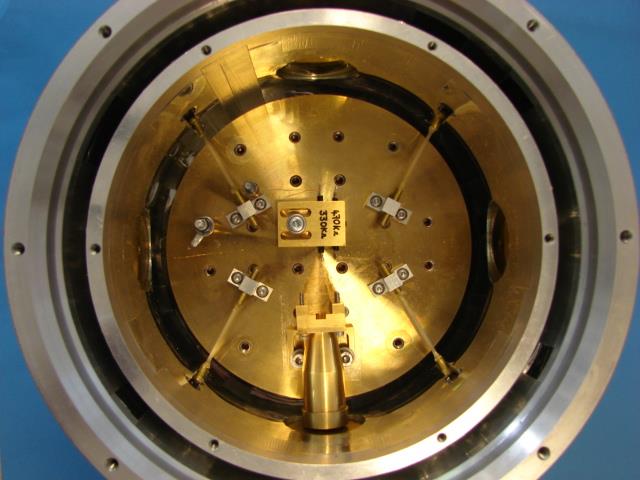| Ports (optics/electrical feedthroughs) | Four on the side of the cryostat * |
| Maximum port clear aperture | 28 mm (77 K radiation shield limit) |
| Electrical connector (standard) | 10 pint low-voltage electrical connector |
| Optic axis height | 20 mm |
| Headroom (when cold) | 77 mm |
| (Helium temperature) cold plate diameter | 125 mm |
| Liquid helium capacity | 1.7 litres |
| Liquid nitrogen capacity | 1.4 litres |
| Hold time, (typical, not including initial fill) | > 10 days (ports blanked, no wiring) |
| 4-5 days (reduced band mm detector) | |
| 2-3 days (broadband mm detector) | |
| Liquid nitrogen hold time (approx) | 18-28 hours |
| Cryostat diameter | 224 mm |
| Cryostat height (excluding lifting handle) | 501 mm |
| Mass (empty) | 19.7 kg |
This dual reservoir cryostat is the smallest QMC cryostat we offer that has both a 77 K liquid nitrogen Dewar and jacket, surrounding a 4.2 K liquid helium central Dewar. The cryostat is intended for use throughout the working week with a once daily top up of the liquid nitrogen Dewar required.
Readying the cryostat for operation i.e. evacuating, and cooling to 4.2 K (liquid helium temperature), can be carried out in about five hours, which includes a four hour liquid nitrogen pre-cool. This can be accomplished sooner with a shorter pre-cool, but this will require more excessive use of the more expensive liquid helium cryogen. Refer to the manual for further details.


Internal view of a TK1813 cryostat showing an inhomgeneously B-field tuned InSb detector fixed to the cold plate. The cold plate hole pattern is non-standard

Full size view of the above schematic.
The standard TK1813 cold plate hole pattern is twenty M4 holes with 20 mm separation (square pattern), running horizontally and vertically across the cold plate. M3 holes for shield support struts and M4 holes for transit posts are also present. Note the non-symmetric positioning of the eight M3 holes - these are closer to the horizontal M4 holes. The support struts that attach the central 4.2K Dewar to the 77K radiation shield are fixed using the M3 holes. Hence you have more room in the 'vertical' band of holes that you do with the horizontal band. An example of this is shown in the photo below. The remaining four M4 holes, one near the outside centre of each quadrant are used to fit transit posts. These posts allow a transit plate to be fitted which offers the cryostat some measure of protection during shipment. The posts are removed prior to use. Note that the standard hole patterns can easily be modified to suit your specific requirements.
The TK1813 cold space dimensions shown here give a vertical cross-section through the cold space area, showing the 20mm optic axis height and window positioning. The headroom when cold is 77mm.

An 'offest port' version of this cryostat is available as a slight modification of the standard cryostat. Three of the four ports are at an optic axis height of 10mm rather than 20mm. This cryostat is designed to work with our broadband millimeter wave detector system that incorporates an internal filter wheel mechanism that holds up to six filters, allowing the user to choose various cold (4.2K) filtering options.